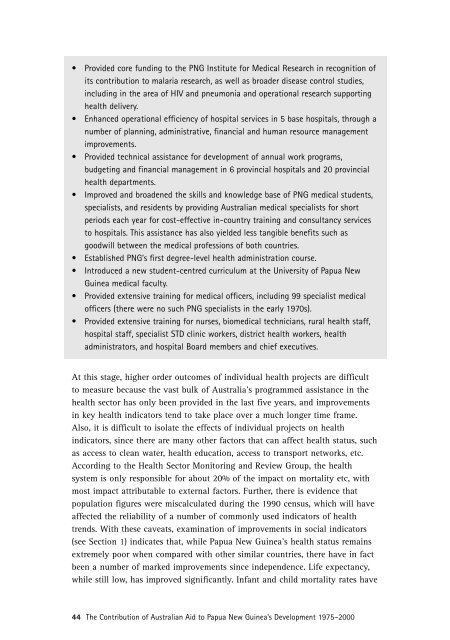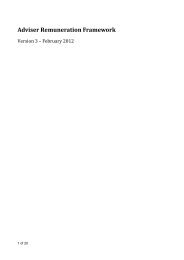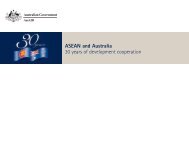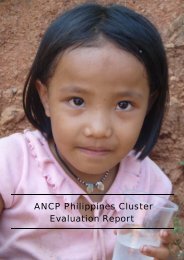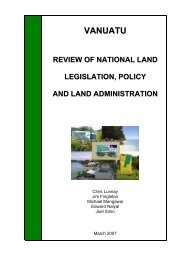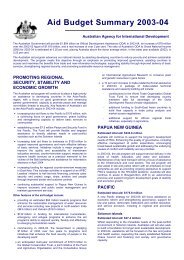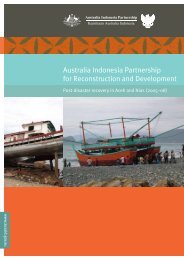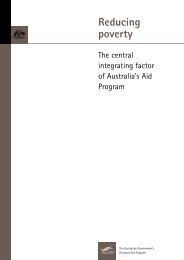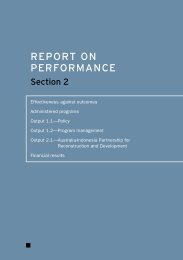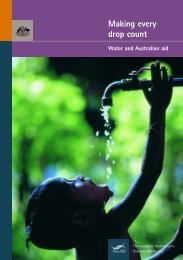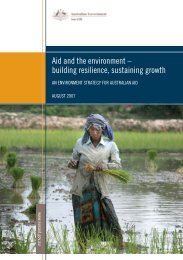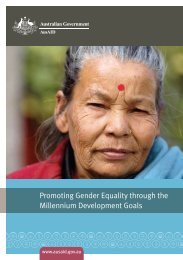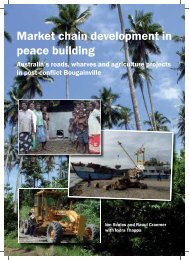Australian Aid to PNG - AusAID
Australian Aid to PNG - AusAID
Australian Aid to PNG - AusAID
You also want an ePaper? Increase the reach of your titles
YUMPU automatically turns print PDFs into web optimized ePapers that Google loves.
• Provided core funding <strong>to</strong> the <strong>PNG</strong> Institute for Medical Research in recognition ofits contribution <strong>to</strong> malaria research, as well as broader disease control studies,including in the area of HIV and pneumonia and operational research supportinghealth delivery.• Enhanced operational efficiency of hospital services in 5 base hospitals, through anumber of planning, administrative, financial and human resource managementimprovements.• Provided technical assistance for development of annual work programs,budgeting and financial management in 6 provincial hospitals and 20 provincialhealth departments.• Improved and broadened the skills and knowledge base of <strong>PNG</strong> medical students,specialists, and residents by providing <strong>Australian</strong> medical specialists for shortperiods each year for cost-effective in-country training and consultancy services<strong>to</strong> hospitals. This assistance has also yielded less tangible benefits such asgoodwill between the medical professions of both countries.• Established <strong>PNG</strong>’s first degree-level health administration course.• Introduced a new student-centred curriculum at the University of Papua NewGuinea medical faculty.• Provided extensive training for medical officers, including 99 specialist medicalofficers (there were no such <strong>PNG</strong> specialists in the early 1970s).• Provided extensive training for nurses, biomedical technicians, rural health staff,hospital staff, specialist STD clinic workers, district health workers, healthadministra<strong>to</strong>rs, and hospital Board members and chief executives.At this stage, higher order outcomes of individual health projects are difficult<strong>to</strong> measure because the vast bulk of Australia’s programmed assistance in thehealth sec<strong>to</strong>r has only been provided in the last five years, and improvementsin key health indica<strong>to</strong>rs tend <strong>to</strong> take place over a much longer time frame.Also, it is difficult <strong>to</strong> isolate the effects of individual projects on healthindica<strong>to</strong>rs, since there are many other fac<strong>to</strong>rs that can affect health status, suchas access <strong>to</strong> clean water, health education, access <strong>to</strong> transport networks, etc.According <strong>to</strong> the Health Sec<strong>to</strong>r Moni<strong>to</strong>ring and Review Group, the healthsystem is only responsible for about 20% of the impact on mortality etc, withmost impact attributable <strong>to</strong> external fac<strong>to</strong>rs. Further, there is evidence thatpopulation figures were miscalculated during the 1990 census, which will haveaffected the reliability of a number of commonly used indica<strong>to</strong>rs of healthtrends. With these caveats, examination of improvements in social indica<strong>to</strong>rs(see Section 1) indicates that, while Papua New Guinea’s health status remainsextremely poor when compared with other similar countries, there have in factbeen a number of marked improvements since independence. Life expectancy,while still low, has improved significantly. Infant and child mortality rates have44 The Contribution of <strong>Australian</strong> <strong>Aid</strong> <strong>to</strong> Papua New Guinea’s Development 1975–2000


